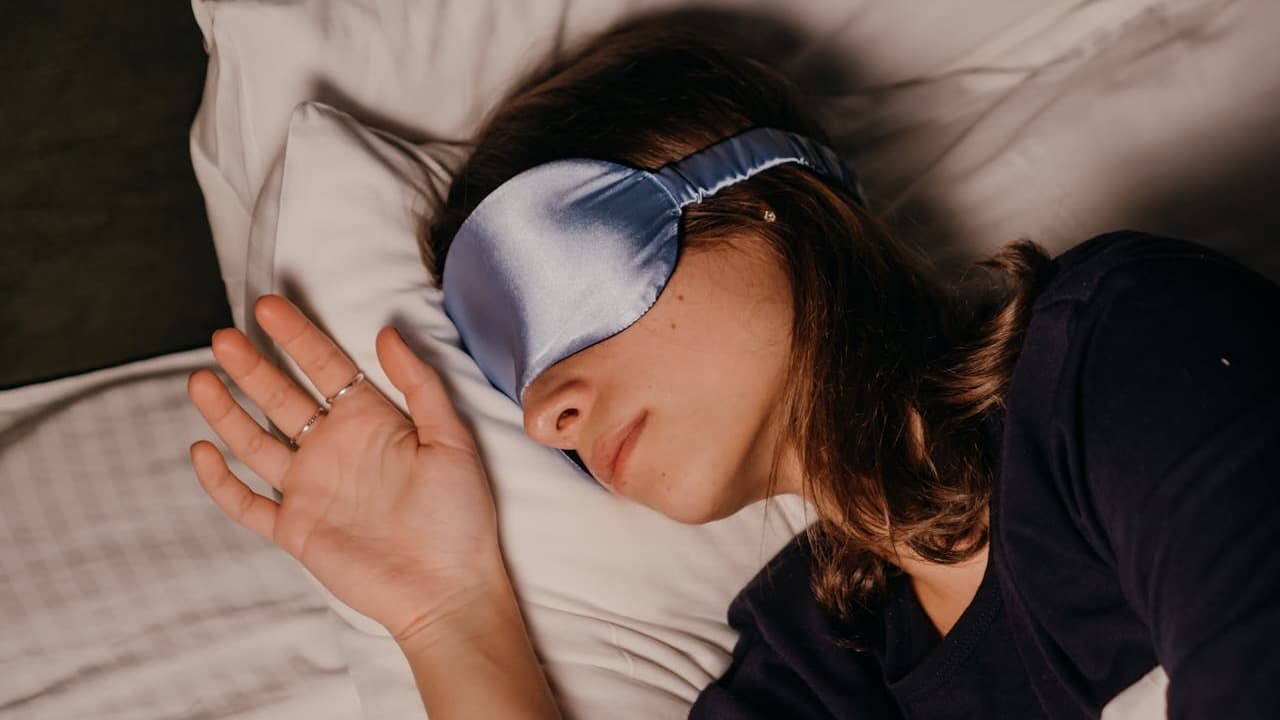
Sleep Mask
A sleep mask is a simple, non-pharmacological tool designed to create an environment of complete darkness. Its primary aim is to block ambient light, which can disrupt the body's natural sleep-wake cycle. By doing so, it supports more restorative sleep, and recent scientific evidence suggests it may also enhance next-day cognitive functions like memory and alertness [26][23][6]. The application is straightforward: a soft mask, typically made of cotton or silk, is worn over the eyes during sleep to prevent light from reaching the retina [26].
The fundamental function of a sleep mask is to prevent light-induced disruption of our internal 24-hour clock, or circadian rhythm. Light, even at dim levels, is detected by specialized cells in the retina (ipRGCs) and signals the brain to suppress the production of melatonin, a key hormone that promotes sleep [11][17][14]. By creating total darkness, a sleep mask ensures a robust and timely release of melatonin, facilitating the transition to sleep and improving sleep quality [9][15].
The benefits are most pronounced in environments with light pollution, such as hospitals. Multiple meta-analyses of studies in intensive care units (ICUs) found that eye masks, often with earplugs, were highly effective non-pharmacological interventions for improving sleep [34][27]. These studies documented significant increases in total sleep time, sleep efficiency, and time spent in the rapid eye movement (REM) phase of sleep, along with a reduction in awakenings [10][34].
Beyond improving sleep architecture, wearing a sleep mask has been linked to enhanced cognitive performance. A 2023 study published in the journal Sleep found that young adults who wore a mask overnight demonstrated superior episodic learning and heightened alertness the following day [26][23]. The researchers linked this cognitive boost to an increased amount of time spent in slow-wave sleep, the deep, restorative stage critical for memory consolidation [23][21]. However, it is worth noting that a subsequent re-analysis has questioned the robustness of these findings, indicating a need for further research [29].
Furthermore, blocking light during sleep has important cardiometabolic implications. Research in the Proceedings of the National Academy of Sciences showed that even a single night of moderate light exposure during sleep increased heart rate and next-morning insulin resistance, likely through activation of the sympathetic nervous system [4][8]. A sleep mask serves as a simple shield against these negative effects [33].
A typical implementation of this protocol involves selecting and consistently using a sleep mask as part of a nightly sleep hygiene routine.
-
Selection: Choose a mask based on material and design. Hypoallergenic materials like high-quality cotton are a good choice [17]. Contoured masks feature molded cups that leave space around the eyes, preventing pressure on the eyelids and lashes, which can be more comfortable [5]. Gel masks contain packs that can be cooled to help alleviate headache pain or puffy eyes [5].
-
Application: The mask should have an adjustable strap to ensure a proper fit [12]. It must be snug enough to block light effectively but not so tight that it causes discomfort or pressure on the eyes [3].
-
Common Pitfalls:
- Improper Fit: A mask that is too tight is a common mistake. This can put pressure on the eyes and cause temporary blurred vision upon waking [5].
- Poor Hygiene: Failing to clean the mask regularly is a significant pitfall. Masks accumulate oils, sweat, and bacteria, which can lead to skin irritation, acne mechanica, or eye infections [17][20]. It is recommended to wash the mask at least once a week if used nightly.
Pros
Cons
Risk to Eye Health: A mask that is too tight can increase pressure on the eyes, causing temporary blurred vision [5]. This is a significant concern for individuals with glaucoma, as external pressure can cause spikes in intraocular pressure (IOP) [24]. People with glaucoma or who have had recent eye surgery should consult their doctor before use [7].
Inconclusive Evidence: The cognitive benefits observed in the 2023 Sleep study were questioned by a subsequent re-analysis, highlighting that more research is needed to solidify these claims [29]. Similarly, the hormonal benefits of weighted masks (e.g., lowering cortisol) are largely theoretical and extrapolated from other therapies, with some studies on weighted blankets finding no significant effect on cortisol [13].
Safety in Infants: Sleep masks are not recommended for infants due to the risk of suffocation [28].
Are sleep masks harmful to your eyes?
According to the American Academy of Ophthalmology, a sleep mask is safe for most healthy individuals as long as it is clean and not too tight [3]. A tight mask can cause temporary blurred vision from pressure on the cornea [5]. Individuals with eye conditions like glaucoma should consult their doctor, as external pressure can be harmful [24].
Can you become dependent on a sleep mask?
There is no evidence of physical dependency [9]. Rather, using a mask can become a powerful psychological cue for sleep as part of a healthy bedtime ritual, signaling to your brain that it is time to rest.
Do sleep masks interfere with REM sleep?
Does wearing a sleep mask cause wrinkles?
This is a common concern, but a well-fitting mask made of a smooth material may actually help prevent "sleep wrinkles" caused by friction and pressure from a pillowcase [22][19]. The mask acts as a protective barrier. However, a mask that is too tight or made of rough material could potentially contribute to skin creases.
Which is better: a sleep mask or blackout curtains?
No direct scientific studies have declared a definitive winner; both are effective at blocking light to support melatonin production [1][25]. The choice depends on lifestyle and environment. A sleep mask is portable, affordable, and personal, making it ideal for travel or shared rooms [16]. Blackout curtains provide a whole-room solution that can also offer noise and thermal insulation but are more expensive and not portable.